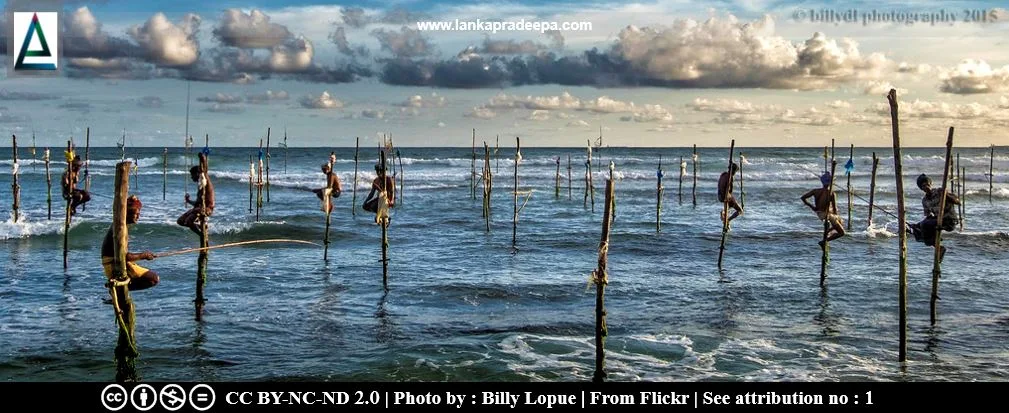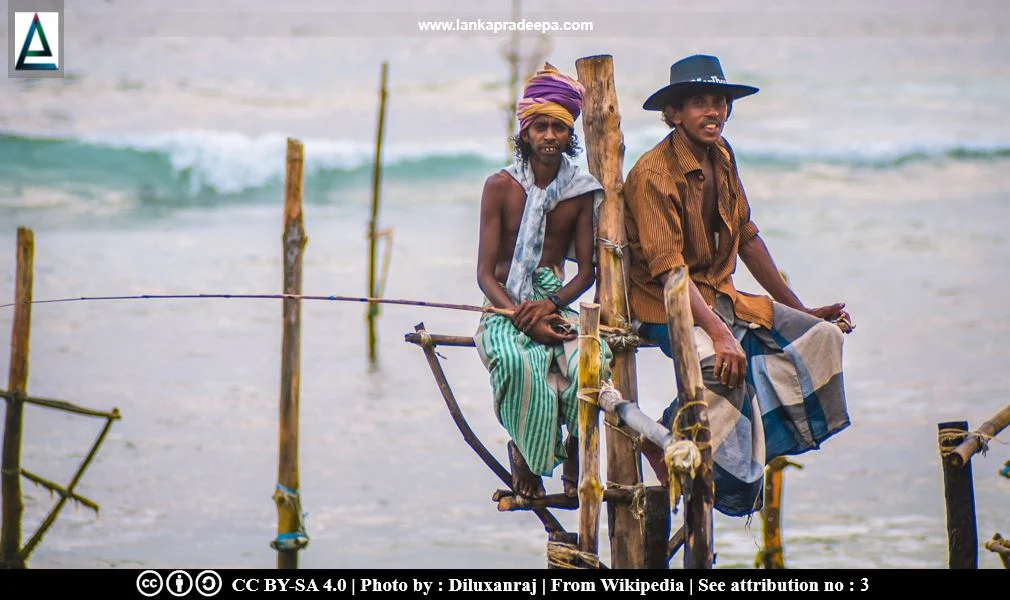
Stilt Fishing, (Sinhala: රිටිපන්න ක්රමයට මසුන් ඇල්ලීම) also termed as Ritipanna Fishing, is a unique method of fishing that cannot be seen in any part of the world except on the southern coast of Sri Lanka from Galle to Matara (Deepananda et al., 2016; Zoysa & Epa, 2009).
The history of stilt fishing is not clear (Nagodawithana, 1996). It has existed for more than 50 years and is considered an important part of the southern coastal economy (Zoysa & Epa, 2009). Although it is a limited form of fishing method and its production is very low, stilt fishing has presently become a tourist attraction due to its unique nature and fishermen earn extra money by charging the tourists (Nagodawithana, 1996).
In this method, the fishermen sit on a crossbar called Petta tied to a vertical pole of 3-4 m long, which is driven into dead coral rock and carry out rod and line fishing (Deepananda et al., 2016; Nagodawithana, 1996). The Petta is tied at a height of about 2 m and the free end of it is tied to another stick which in turn is tied to the vertical pole to support the Petta. The stilts are normally erected within walking distance of the beach generally up to about the level of the hips of the fishermen (Nagodawithana, 1996). One or more shorter sticks may be tied below the Petta to serve as steps (Nagodawithana, 1996).
In stilt fishing, the fishers use fisher made, non-baited, specific hooks made of lead (Deepananda et al., 2016). The main fish species targeted by them are Ahalaburuwa (young Koraburuwa), Koraburuwa (spotted herring, Herklotsichth punctatus) and Bolla [(small mackerel) Nagodawithana, 1996]. The fishing season starts with the beginning of the southwest monsoon (April-May) and extends till the end of the monsoon [(September-October) Nagodawithana, 1996].
 .
.See also
Attribution
1) Stilt fishermen by Billy Lopue is licensed under CC BY-NC-ND 2.0
2) 20160129_Sri Lanka_4181 crop Ahangama by Dan Lundberg is licensed under CC BY-SA 2.0
References
1) Deepananda, K.A., Amarasinghe, U.S., Jayasinghe-Mudalige, U.K. and Berkes, F., 2016. Stilt fisher knowledge in southern Sri Lanka as an expert system: a strategy towards co-management. Fisheries research, 174, pp.288-297.
2) Nagodawithana, M.T.K., Lanka, S., Morris, M.J., Hotta, M. and Ratapatu, A.R., 1996. Stilt fishing in Kathaluwa and Ahangama (Habaraduwa). In Sri Lanka/FAO national workshop on development of community based fishery management. pp.7,113-116.
3) Zoysa, M.C.L. and Epa, U.P.K., 2009. Effects of abiotic environmental factors on fish yield from traditional stilt fishery in. In Proceedings of International Forestry and Environment Symposium (Vol. 14). p.
This page was last updated on 6 May 2022
For a complete tourist map follow this link: Lankapradeepa Tourist Map
For a complete tourist map follow this link: Lankapradeepa Tourist Map


